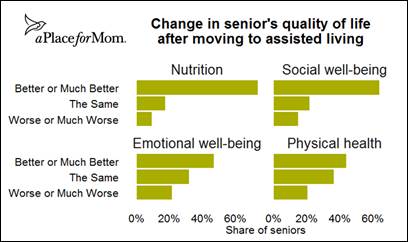
Results of new research give assisted living marketing and sales professionals fresh data to share with prospective residents and their families about benefits both can experience when an older adult moves into a residential community.
Seventy-three percent of families who participated in a survey by Seattle-based A Place for Mom said that an older loved one’s quality of life improved after moving to into an assisted living community.
Further, 60% of family caregivers found that their personal quality of life improved, according to the senior living referral service, and 70% said that the financial impact of the move was insignificant to them.
“With this study and the two that we posted before, part of the goal is to help change the perception of senior living among consumers with real information,” Charlie Severn, vice president of brand marketing for A Place for Mom, told McKnight’s Senior Living. “One of the ways that communities can leverage this information is to have an active discussion with families when they’re touring a community, around some of the benefits, beyond the living environment, of a senior moving into senior living, and backing that up with statistics.”
The survey included responses from family members of those who had moved into assisted living communities as well as family members of seniors who were still searching for seniors housing. Although the survey was conducted only among family members and did not include the older adults themselves, the results closely mirrored those of studies in which older adults participated, so A Place for Mom is confident that they accurately reflect the experiences of older adults as well as their family members. Sage Projections, a Seattle-based research and consulting company, consulted on the survey and provided validation of its development, methodology and interpretation of results.
Overall, 85% of families surveyed said they delayed their senior living searches because the older adult in their lives didn’t want to move or because a family member associated substandard care with assisted living. Sixty-two percent of seniors initially said they would rather continue living at home and be taken care of by someone they know, and half of family members said they started out with a neutral or negative perception of assisted living communities, A Place for Mom said.
 Contrary to their initial expectations, however, both seniors and family caregivers experienced a positive change in overall quality of life after the older adult moved to assisted living, according to respondents. In fact, seniors who moved were 70% more likely than those considering a move to report a good overall quality of life, and they were 65% less likely to have a bad overall quality of life, the survey found. And once a senior had moved, he or she was five times more likely to see overall quality of life improve rather than worsen.
Contrary to their initial expectations, however, both seniors and family caregivers experienced a positive change in overall quality of life after the older adult moved to assisted living, according to respondents. In fact, seniors who moved were 70% more likely than those considering a move to report a good overall quality of life, and they were 65% less likely to have a bad overall quality of life, the survey found. And once a senior had moved, he or she was five times more likely to see overall quality of life improve rather than worsen.
Seventy-three percent of families reported that their senior loved one’s quality of life got better or much better. The same percentage of respondents reported an improvement in the older adult’s nutrition, 64% saw social well-being improve, 47% saw emotional well-being improve and 44% saw physical health improve.
Benefits for family members
A move didn’t just benefit the older adult, however. It also benefited their family members, A Place for Mom found.
Family caregivers said they experienced improvements in stress, diet, exercise and work without sacrificing their financial well-being. Of the families who had a parent or loved one move, 60% said their own quality of life improved. And half of the families who helped a parent or loved one move said their relationship with the senior improved.
“That’s an important potential talking point for senior living communities as they talk with families, centered on a relationship with parents,” Severn said. “The fact is, when they’re staying at home, there’s this hidden stress that potentially gets in the way of that relationship. By having more peace of mind about the health and safety of their parents and that they are in a good place, it really allows a better relationship for these sons and daughters. It’s an incredible value that I don’t think you can really put a dollar number around. It’s your parents, and you have one shot to have a great relationship.”
Family members were 24% more likely to have a good or very good quality of life if the senior moved than if the family still was considering a move to an assisted living community for a loved one, the survey found. Overall, 64% of families who helped a loved one make a move reported feeling less stress about their senior loved ones. Additionally, 32% of families who transitioned reported healthier or much healthier diets and exercise levels after the move.
Financial considerations
Although many families may be wary about the potential financial burden of relocating a senior into an assisted living community, they also may not realize the hidden costs of having a senior age at home, A Place for Mom said.
“If someone is needing to make a move into assisted living, it’s likely they have some care needs that are being handled at home, so there’s potentially some home care costs that should be calculated into the equation,” Severn said. “And then there’s still the cost of the home itself and the upkeep. Potentially you have a mortgage. You certainly have taxes, and then you have upkeep. And not only is there a financial cost, but there’s stress with that. If you take all of that into the equation, you can have a pretty balanced view of the cost of staying at home versus the cost of senior living and all the benefits of it.”
The monetary well-being of caregivers largely was unaffected after a senior moved, the survey found, with more than 70% of families reporting feeling that their financial situations had not changed.
Moves also opened the door for greater earning potential for caregivers. Of families who helped a loved one make a move, 39% reported less impact of caregiving on their careers.
“I’d love to continue to do research on this and see how the impact of moving to an assisted living on family member quality of life differs for family members based on how much care they provided before the move,” Ben Hanowell, a data scientist at A Place for Mom, told McKnight’s Senior Living.
This study was the third installment in a quarterly series of data reports by A Place for Mom. See articles on the previous installments here:
It’s a good time for a move to senior living, data show
Care needs greatest determinant of senior living search length



